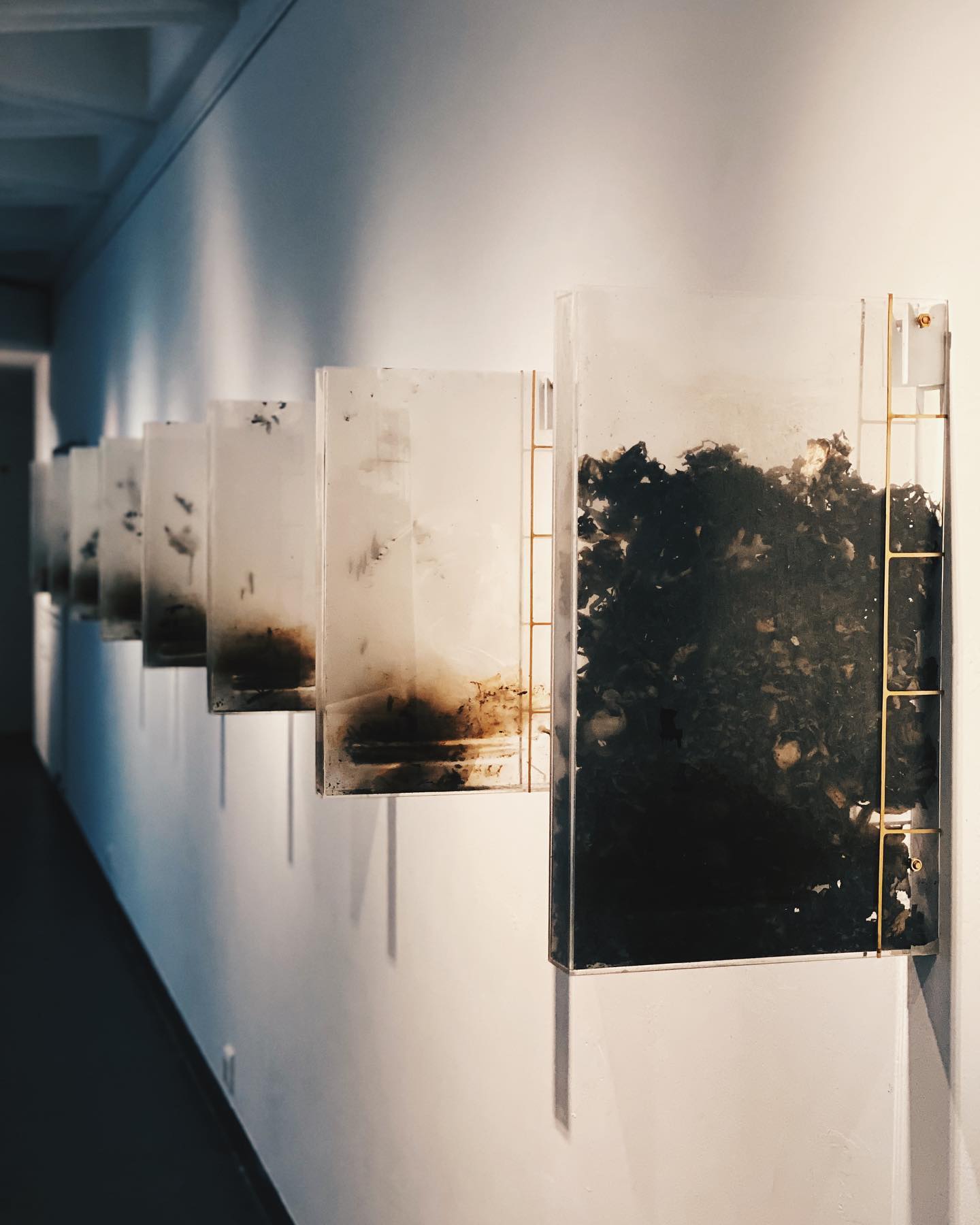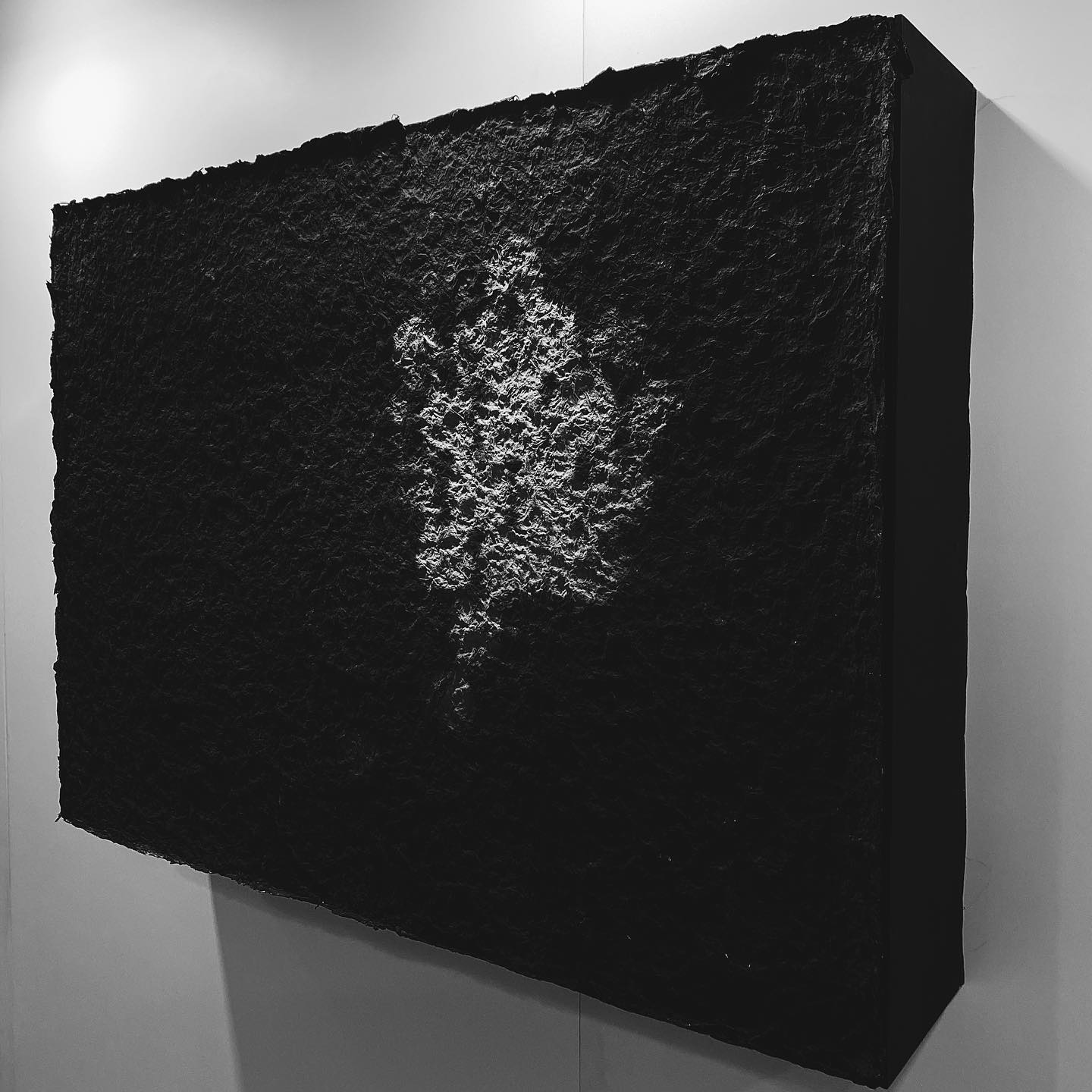張瀚謙(Chris Cheung Hon Him,下稱Chris)的工作室佈滿古石,少有數百件,古石正是他下一件作品的研究主題及載體。他畢業自香港城市大學創意媒體學院 (School of Creative Media,下稱SCM),從事創作十多年,其媒體藝術背景,與他喜歡鑽研中國或傳統藝術並無抵觸,反而有助他把當中的精神以簇新的方式呈現。人工智能、互動程式、演算技術,與中國書法、盆景或各種「道」學並置,以不斷向前的科學科技回溯,探問傳統,尋求突破點,時而回應社會事件,時而營造新的感官體驗,在新與舊之間游走,正是他的創作之道。
「這些石頭已經歷了不知多少億年,那是在侏羅紀之前,人們稱為震旦紀時代形成的,它們經歷了很多,我幻想著它們所記載的故事。」甫見面,Chris便詳盡地分享他近年收藏的原石,起始之源是他前往日本參與藝術家駐留計劃,在留日期間,他了解到近代一群反儒、道思想的日本文人,在中國哲學與美學的影響下,試著打破傳統,發展出幽玄或侘寂等概念,以確立日本獨有的美學系統:「如日本園庭的『枯山水』與中式園林設計便是兩個極端:中式園庭設計是『動』的,講究『移步入境』,造園上以不同方法令觀者目不睱給,每走一步都發現新事物;反觀日本的園庭藝術,是有靜態的感覺,營造出一種氣氛去體驗整個空間。」
他跟隨日本一位盆景大師學習,慢慢摸塑作品所帶的禪意:「我的老師提出了一個很重要的概念,亦是日本的傳統美學──物哀。這是鑑賞大自然之美的一種表現,或是憐惜大自然的一種同理心。 」由盆景藝術開始,Chris繼而接觸「景道」:「這是日本人近一百年發展出來的想法,意思是將茶道、空間的藝術、空間之道等結合成為一種體現空間的美學。」這段歷程令Chris對於傳統藝術該如何演化有莫大反思,這些精神亦反映在他近年的作品上,他以媒體藝術為介面,挖掘傳統,尋找可打破的東西:「我有一系列的作品是水墨,以新方式呈現當中的襌、道概念,未來亦將發展一系列關於賞石文化的創作,近這幾年,我作品的主題都與這些有關。」
自小學習中西樂器,音樂是Chris接觸藝術的起點,唸大學時他選修了數碼視覺設計,再入讀SCM。畢業後,他借鑑國外一些前瞻性藝術團隊的概念,與擅長不同媒介的同學於2007年成立跨媒介創作團隊XEX group(現重組及另名為XCEPT及XCEED),希望在創作上可激發一些火花。十多年時間的累積之下,他那些結合傳統和未來的作品獲得不少奬項,亦不間斷地於世界各地展演。

燼忘錄 I The Book of Ashes.
Photo: Courtesy of Chris Cheung.
雖然研讀的科目和創作所呈現的觀感與科技息息相關,這十年亦見證著媒體技術的改變,Chris卻更像位考古學家,如對遠古的文字便顯現出莫大興趣。當問及科技的更迭如何影響人類的日常生活,甚或最終可能會導致文字或某些藝術形成漸漸消失,他便提到:「我們以前的文字,是刻劃在洞穴上的,更早一點,甚至沒有文字,如遠古文明的『繩結時代』,人們光以繩結溝通。」他曾到訪過秘魯,見識過這些繩結書,不禁以現代的角度思考:「雖然至今仍然沒有人可解讀這些『文字』,但顯然一本書是可以1010的概念製成的,即是說,那個年代已經有coding(編碼)或digital(數位)的概念。」這些消失了的文化,令他反覆推敲人類的科技發展史裡文明所經歷過的轉變,正如此時此刻,我們平日使用的工具,或會有被淘汰的一日。

墨潮 - 自由之境 I InkFlux- Flowin’ in the Wind. Photo: Courtesy of Chris Cheung.
他以冷靜的思維面對這類狀況,他坦言:「這未必是件可惜的事。」正如媒體藝術或新媒體的作用,令他多了一種方法或工具去改變一些傳統媒介,他在意的更加是如何運用這些工具,並分析科技背後帶來的涵意:「包括在感官的體驗上,正如以前集中於文字的溝通,我們現今對世界的感知,多了身體性的『語境』。」
如Bio-tech (生物科技) 或Bio-art (生物藝術),或會於不久的將來改變人類接收資訊的方法。有見及此,媒體藝術的重點不再只單純與其互動性有關,「反而是我們的感知和刺激正置於媒體轉型的關鍵時間,如有了網絡以及雲端這些新科技後,對人的感知有很大的影響。有些研究指出,人類在收集資訊時,要是那些資訊不能在一或兩秒內吸引眼球,便會被略過,這些都在證明我們的感知已慢慢改變。」
他因此更在意如何以新的思維去感知或表達傳統藝術的內涵:「如傳統的書畫,現代人與前人觀賞畫作時所花費的時間和耐性,已與以往不同。這亦是我們面對新媒體或媒體藝術常常會遇到的問題,該如何接觸觀者?讓他們與作品構成對話或溝通?」
他反覆在自己的作品中實驗不同方法,因為傳承在他眼中,是把前人留下來的美學,更進一步地呈現,如《子非魚》便以莊子道家哲學為靈感,探討主客觀念與互動自主性的關係;《墨池記》蒐集了古代書法大家的字跡,透過電腦學習,以數據勾勒出橫豎撇捺;在《墨潮》裡,他想像潮水又退又進的狀態,呈現出襌畫即現即逝的美學觀,如他所言:「媒體藝術有趣之處是可以運用無邊界的事物,以技術的幫助去與空間以及觀眾建立新的關係。」
他自覺這是他身為一位立足於香港的藝術家可以做的事,「香港的狀態就是一個浮城,我們被兩邊(中與西)的力量拉扯,沒有一個根源,但這正正是可以發揮的著眼點,因為我們沒有包袱,不需要定義自己為中國藝術家或是西方藝術家,我們既可有傳承的一面,亦可將之打破。」
張瀚謙是一位以前衛電子視聽表演和新媒體藝術裝置聞名的藝術家,作品包括《子非魚》、《封筆》、《碳境》及《墨潮》等。
張氏創作風格與美學觀獨特,揉合傳統和未來的概念,亦把其對中國哲學的詮釋融會貫通。他早於2008年成立新媒體藝術團隊XCEPT / XCEED (前身為XEX),展覽作品巡迴世界各地,並屢獲國際獎項及藝術節垂青,先後在德國紅點設計獎、紐約字體藝術指導俱樂部、英國Lumen Prize、荷蘭Frame Awards、深圳GCD11、日本字體設計協會、香港Good Design Award、亞洲最具影響力設計大奬和紐約藝術指導暨11屆青年先鋒年賽展取得奬項,並於2010年獲香港藝術發展局和香港設計中心分別頒發「香港青年設計才俊大獎」。
張氏亦在2014年擔任首屆深港設計雙年展藝術顧問及策展人,並為不同的國際論壇,包括:佳士得Art+Tech藝術科技峰會、美國Eyeo和設計營商週作演講嘉賓,最近建立了XPLOR實驗室和FutreTense平台,致力推新媒體藝術發展。
Chris Cheung Hon Him is best known for installation art and audiovisual performance, whose artistic expression depends upon electronic, sound, image and creative technology in new media. His reverence for Chinese philosophy is central to his oeuvre, which he blends traditional ideology and futuristic imagination to create immersive soundscape, generative art and data art.
Chris is always eager to explore new mediums and look for aesthetics in technological intervention. He established artist collective, XCEPT and XCEED (formerly XEX) in 2008. The collective works are showcased worldwide and have won prestigious international awards in the Reddot, Type Directors Club Annual Exhibition, Lumen Prize, Frame, GDC 11, A’ Design, Golden Pin, Design for Asia awards and New York Art Director Club Young Guns 11. He received the Young Artist Award from Hong Kong Arts Development Council and the Young Design Talent Awards from Hong Kong Design Centre in 2010 and 2011 respectively.
In 2014, he was appointed as the Curator and Artistic Consultant of the 1st HK-SZ Design Biennale and has been invited as guest speaker in multiple global events including Christie’s Art and Tech Summit, Eyeo Festival and Business of Design Week. His dedication to cultivating art, tech and future living in local community has inspired him to set up XPLOR lab and FutureTense platform lately.
He initiated the project “RadianceScape” back in 2014. The work has garnered critical acclaim and was featured in Ars Electronica, FILE Festival, EMAF and other festivals. The live performance was toured in Sónar Festival and WRO Art Biennale in 2007.
Recently, Taoyuan Museum of Fine Arts has collected his calligraphy installation, “Mochiji” and his ink work, “InkFlux”, is now included in the UOB Art collection. His soundscape installations, “Prismverse” and “CarbonScape”, have attracted significant attention from international media and come under the spotlight of CNN Style, Mashable, Wired, Fubiz, Designboom, CreativeApplications, and so on.
courtesy @h0nh1m
- 多媒體
- 表演藝術
- 聲音藝術
- 考古
- 劇場
- 音樂
- 科技
- 歷史
- 文化
- 設計
- 文化衝擊
- 中國藝術
- 西方藝術
- 實驗水墨
- 參與
- 商業性
- 聲畫
- 文化身份
- 影像騎師
- 應用程式
- 當代藝術
- 尖端
- 機器
- 媒體藝術家
- 編程
- 實時
- 數據
- 數據藝術
- 達達主義
- 創意媒體學院
- 錄映太奇
- 電影
- 白南準
- 微波國際新媒體藝術節
- 錄像藝術
- 美學
- 香港城市大學
- 擴張實境
- 科技藝術
- 藝術科技
- 社交媒體
- 動畫
- 裝置藝術
- John Cage
- XEX Group
- Dump Type
- Yellow Magic Orchestra (YMO)
- NTT ICC(Inter communication Center)
- 板本龍一
- 創意媒體中心
- 池田亮司
- 森美術館
- 媒介
- 黑川良一
- 翻轉板
- 集體藝術創作
- 介面
- 可穿戴式裝置
- 雲端系統
- 變革
- 語境
- 起點
- 工業產物
- 浮城誌異
- 數碼視覺設計
- 藝術家駐留
- 前瞻性的藝術團隊
- 知覺
- 富德樓
- 刺激
- 集體
- 對話
- 人工智能
- 機器學習

